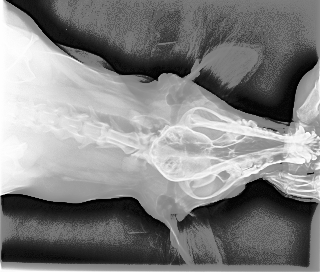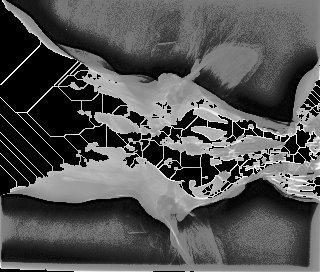L_SkeletonBitmap (original) (raw)
Summary
Finds the skeleton of objects or regions in a bitmap.
Syntax
#include "l_bitmap.h"
L_LTIMGEFX_API L_INT L_SkeletonBitmap(pBitmap, nThreshold, uFlags)
Parameters
pBITMAPHANDLE pBitmap
Pointer to the bitmap handle that references the bitmap for which to find the skeleton.
L_INT nThreshold
Threshold value used to binarize the bitmap before finding the skeleton. This parameter is ignored if the bitmap is a binary bitmap. The threshold range for 16, 48 and 64-bit images is from 0 to 65535 for unsigned images, and from 32768 to +32767 for signed images. For 12-bit images, the threshold range is from 0 to 4095 for unsigned images, and from 2048 to +2047 for signed images. Otherwise, it is from 0 to 255.
L_UINT32 uFlags
Reserved for future use. Must be 0.
Returns
| Value | Meaning |
|---|---|
| SUCCESS | The function was successful. |
| < 1 | An error occurred. Refer to Return Codes. |
Comments
This function finds the skeleton of regions or objects in a binary bitmap. The white color represents the objects and the black color represents the background. If the bitmap is not a 1-bit image, the threshold will be used to transform the bitmap into a binary image before finding the skeleton.
If the bitmap has a region, this function works only on the region.
This function supports 12 and 16-bit grayscale and 48 and 64-bit color images. Support for 12 and 16-bit grayscale and 48 and 64-bit color images is available in the Document and Medical Imaging toolkits.
To update a status bar or detect a user interrupt during execution of this function, refer to L_SetStatusCallback.
This function does not support 32-bit grayscale images. It returns the error code ERROR_GRAY32_UNSUPPORTED if a 32-bit grayscale image is passed to this function.
Skeleton Function - Before

Skeleton Function - After

View additional platform support for this Skeleton function.
Required DLLs and Libraries
- LTIMGEFX
- For a listing of the exact DLLs and Libraries needed, based on the toolkit version, refer to Files To Be Included With Your Application.
Platforms
Win32, x64, Linux.
See Also
Functions
- L_CombineBitmap
- L_IntensityDetectBitmap
- L_SharpenBitmap
- L_SpatialFilterBitmap
- L_EdgeDetectorBitmap
- L_GlowFilterBitmap
- L_CorrelationBitmap
- L_DiffuseGlowBitmap
- L_HighPassFilterBitmap
- L_MaskConvolutionBitmap
Topics
- Detecting and Enhancing Edges and Lines
- Raster Image Functions: Image Processing: Filtering Images
- Color Halftone and Halftone Images
- Raster Image Functions: Detecting and Enhancing Edges and Lines
Example
This example loads a bitmap and finds its edges using L_EdgeDetectorBitmap then produces the skeleton of these edges
L_INT SkeletonBitmapExample(L_VOID)
{
L_INT nRet;
BITMAPHANDLE LeadBitmap; /* Bitmap handle to hold the loaded image. */
/* Load the bitmap, keeping the bits per pixel of the file */
nRet = L_LoadBitmap(MAKE_IMAGE_PATH(TEXT("sample5.cmp")), &LeadBitmap, sizeof(BITMAPHANDLE), 0, ORDER_BGR, NULL, NULL);
if (nRet != SUCCESS)
return nRet;
/* Find the edges in the bitmap*/
nRet = L_EdgeDetectorBitmap(&LeadBitmap, 60, EDG_SOBEL_ALL, 0);
if (nRet != SUCCESS)
return nRet;
nRet = L_SkeletonBitmap(&LeadBitmap, 128, 0);
if (nRet != SUCCESS)
return nRet;
nRet = L_SaveBitmap(MAKE_IMAGE_PATH(TEXT("Result.BMP")), &LeadBitmap, FILE_BMP, 24, 0, NULL);
if (nRet != SUCCESS)
return nRet;
//free bitmap
if (LeadBitmap.Flags.Allocated)
L_FreeBitmap(&LeadBitmap);
return SUCCESS;
}